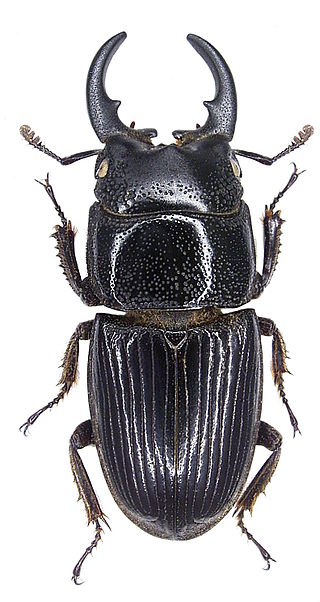
Stag beetles comprise the family Lucanidae. It has about 1,200 species of beetles in four subfamilies. Some species grow to over 12 centimetres, but most to about 5 cm (2 in).

Lucanus cervus, known as the European stag beetle, or the greater stag beetle, is one of the best-known species of stag beetle in Western Europe, and is the eponymous example of the genus. L. cervus is listed as Near Threatened by the IUCN Red List.

Odontolabis cuvera, the golden stag beetle, is a beetle of the family Lucanidae, stag beetles.
The Lucanidae are a family of beetles that include the stag beetles. The classification presented here follows Smith (2006), with the exception of the tribal classification within the Lucaninae.

Chiasognathus is a genus of stag beetles found in Argentina and Chile. It includes seven species:

Cyclommatus metallifer is a species of stag beetle in the family Lucanidae. There is sexual dimorphism within the species. Males are generally larger in size and have enlarged mandibles. It is named for its metallic coloration, which ranges in color and may be varying levels of black, brown, or gold. This species is notably easy to maintain, making it a useful species for scientific study. Additionally, it has been kept as an exotic pet.

Platycerus caraboides is a species of stag beetle belonging to the family Lucanidae, subfamily Lucaninae.

The western Hercules beetle is a species of rhinoceros beetle that lives in Arizona, New Mexico and Utah in the United States and in parts of northern Mexico. This species is known for its grayish-white elytra, large size, and characteristic horn of the adult males.

Cyclommatus is a genus of the family Lucanidae, also known as the stag beetle. The majority of the species from the genus Cyclommatus are located in Southeast Asia, though some species are found in China and Taiwan as well. The genus Cyclommatus also consists of three subgenera: Cyclommatus, Cyclommatinus and Cyclommatellus. Each subgenera contains 80, 24 and 3 species respectively. In total, the genus Cyclommatus consists of a total of 134 species, though more are still being discovered to this day.

Hexarthrius parryi, the fighting giant stag beetle, is a species of large stag beetles. It belongs to the genus Hexarthrius of the tribe Lucanini. It is classified under the subfamily Lucaninae of the stag beetle family Lucanidae.

Leptinopterus tibialis is a species of beetles belonging to the family Lucanidae.

Apterocyclus honoluluensis, the Kauai flightless stag beetle, is a species of stag beetle in the family Lucanidae. It is found on the island of Kauai in the Hawaiian Islands.

Apterocyclus palmatus is a species of stag beetle in the family Lucanidae. It is found on the island of Kauai in the Hawaiian Islands.

Apterocyclus is a genus of rare stag beetles in the family Lucanidae. There are about five described species in Apterocyclus. The species of Apterocyclus are found only on the island of Kauai in the Hawaiian Islands, and are the only scarabaeoid beetles native to the Hawaiian Islands.

Apterocyclus kawaii is a species of stag beetle in the family Lucanidae. It is found on the island of Kauai in the Hawaiian Islands.

Apterocyclus waterhousei is a species of stag beetle in the family Lucanidae. The rare, flightless beetle is found only on the island of Kauai in the Hawaiian Islands. It has been reported in several locations on the island in recent years.
Chiasognathus sombrus is a beetle which belongs to the family of stag beetles (Lucanidae) in the group Scarabaeoidea.
Dinonigidius bartolozzii, is a species of stag beetle endemic to Sri Lanka.

Aegus chelifer, is a species of stag beetle found in Indo-Malaya regional countries.

Dorcus hopei is a beetle in the family Lucanidae.


















